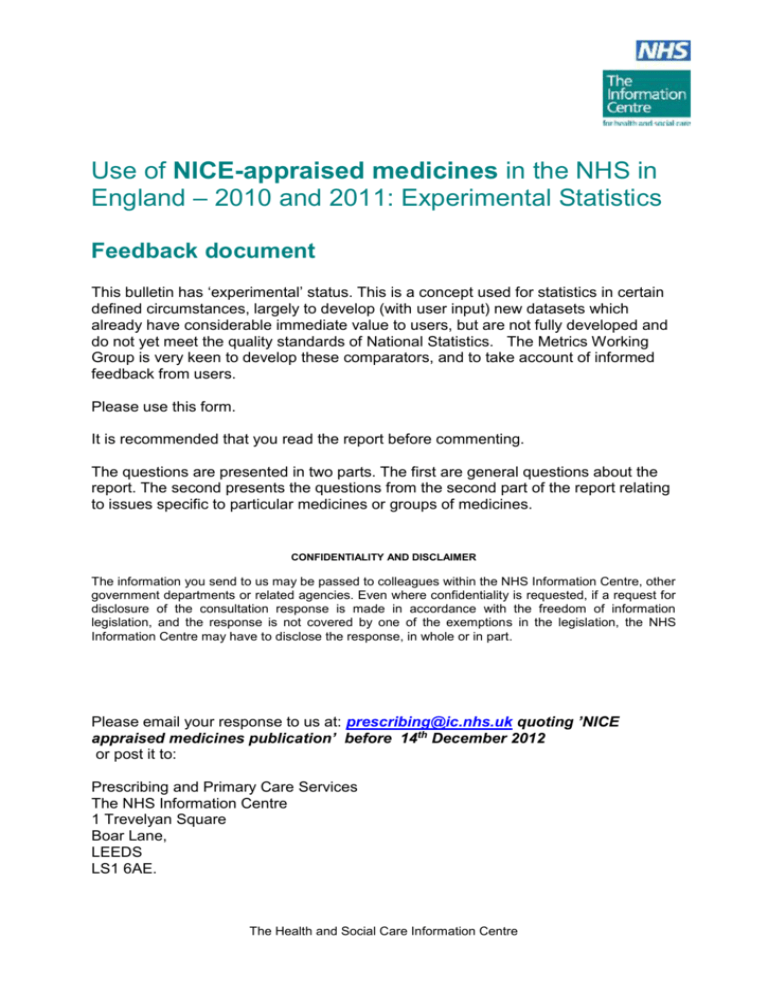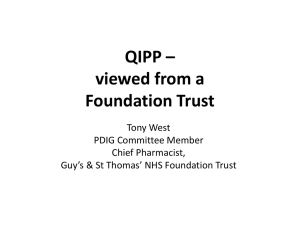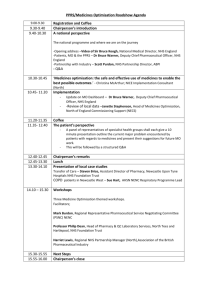Use of NICE appraised medicines in the NHS in England
advertisement

Use of NICE-appraised medicines in the NHS in England – 2010 and 2011: Experimental Statistics Feedback document This bulletin has ‘experimental’ status. This is a concept used for statistics in certain defined circumstances, largely to develop (with user input) new datasets which already have considerable immediate value to users, but are not fully developed and do not yet meet the quality standards of National Statistics. The Metrics Working Group is very keen to develop these comparators, and to take account of informed feedback from users. Please use this form. It is recommended that you read the report before commenting. The questions are presented in two parts. The first are general questions about the report. The second presents the questions from the second part of the report relating to issues specific to particular medicines or groups of medicines. CONFIDENTIALITY AND DISCLAIMER The information you send to us may be passed to colleagues within the NHS Information Centre, other government departments or related agencies. Even where confidentiality is requested, if a request for disclosure of the consultation response is made in accordance with the freedom of information legislation, and the response is not covered by one of the exemptions in the legislation, the NHS Information Centre may have to disclose the response, in whole or in part. Please email your response to us at: prescribing@ic.nhs.uk quoting ’NICE appraised medicines publication’ before 14th December 2012 or post it to: Prescribing and Primary Care Services The NHS Information Centre 1 Trevelyan Square Boar Lane, LEEDS LS1 6AE. The Health and Social Care Information Centre Use of NICE-appraised medicines in the NHS in England – 2010 and 2011 Experimental Statistics Responses To help us analyse the responses, please complete the contact information at the beginning of the form below. Space is provided for written comments on each question. The boxes will extend as required. Name: Name of Organisation: Address: Postcode: Email: Telephone (include STD code): Are you responding as an: Organisation: Individual: What is your role/title? If responding on behalf of an organisation, please mark your Organisation Type from the list below with an ‘x’: Academic Charity Government Agency Government Department 2 The Health and Social Care Information Centre Use of NICE-appraised medicines in the NHS in England – 2010 and 2011 Experimental Statistics Informatics Specialist General Practice NHS PCT/SHA NHS Hospital Trust NHS Special Health Authority Other NHS Organisation Patient Support Group Pharmaceutical Industry Public Health Observatory Professional Association Consultancy/Research Organisation Other - please specify Thank you for taking the time to give us your views. 3 The Health and Social Care Information Centre Use of NICE-appraised medicines in the NHS in England – 2010 and 2011 Experimental Statistics GENERAL QUESTIONS Q.1a. Is this report of interest to you? Why/Why not? Q.1b. What additional information would be of interest? Please provide any views or comments in the box below How can the current methodology be improved? Q2a. Have you any comments on how NICE estimates the number of eligible patients (ie the number expected to receive a specific treatment)? Q2b. And how can local variations (at Cancer Network, SHA and PCT level) be incorporated? Please provide any views or comments in the box below 4 The Health and Social Care Information Centre Use of NICE-appraised medicines in the NHS in England – 2010 and 2011 Experimental Statistics Q3a. We are keen to investigate how best to present data for drugs which have multiple indications, as it is not possible to differentiate use from current prescribing data. For example, should drug use for all indications be combined, or could sample data be used as a basis for allocating use to different indications? Please provide any views or comments in the box below Q3b. We are keen to investigate how best to present data where there are a number of drugs that can be ‘considered as an option’ for the management of a condition. The alternative therapies may also be appraised by NICE, and some may not have been appraised. For example, should these be shown individually or combined? Please provide any views or comments in the box below Q8. Are there any other issues you would like to raise? Please provide any views or comments in the box below 5 The Health and Social Care Information Centre Use of NICE-appraised medicines in the NHS in England – 2010 and 2011 Experimental Statistics Q4a. Do you have any views on the use of data provided by pharmaceutical companies? For example should this be validated, if so, how? Q4b. Are there other data sources that could be used? Please provide any views and comments in the box below. Q5. Do you have any views on how we might collect data for the areas where we have had difficulty (e.g. for mental health trusts, supplies via the homecare route, etc)? Please provide any views and comments in the box below. 6 The Health and Social Care Information Centre Use of NICE-appraised medicines in the NHS in England – 2010 and 2011 Experimental Statistics Q6. Do you have any comments on the results presented in this report? Please provide any views and comments in the box below See Warren – what do uyou think Q7. Do you have any comments on the format of this report? Please provide any views and comments in the box below 7 The Health and Social Care Information Centre Use of NICE-appraised medicines in the NHS in England – 2010 and 2011 Experimental Statistics SPECIFIC QUESTIONS Pioglitazone 1. How can the number of patients with risk factors which would contraindicate pioglitazone use be estimated? Breast cancer (early) - hormonal treatments 1. How can the data on the use of these medicines be obtained by diagnosis / stage of disease and phase of treatment (1st line, 2nd line)? 2. If data cannot be obtained by diagnosis, how can an estimate of expected use be constructed where technology appraisal guidance on appropriate use of these medicines does not cover all indications? 3. Are there estimates of the relative proportions of early and advanced breast cancer (ideally at SHA/Cancer Network level) which could be used here? Capecitabine 1. How can the data on the use of medicines by diagnosis be obtained? 2. If data cannot be obtained by diagnosis, how can an estimate of expected use be constructed where technology appraisal guidance on appropriate use of these medicines does not cover all indications? 3. Where a medicine is one treatment option amongst others, how can estimates and usage data account for alternative treatment options? This is a particularly difficulty in the case of cancer medicines. Also where the alternative options have multiple indications, their use is not available by diagnosis. Getfitinib 1. How can an estimate of the proportion of patients being treated with the different options be produced? 2. What data exists to support this analysis? Omaluzimab 1. Are there alternative sources of data representative of clinical practice, which would allow an exploration of the number of patients who respond to treatment vs. non responders? 8 The Health and Social Care Information Centre Use of NICE-appraised medicines in the NHS in England – 2010 and 2011 Experimental Statistics Peginterferons for Hepatitis C 1. How can we obtain sub-national estimates by genotype? How can we obtain figures on informed dissent? Are there robust estimates of re-infection? How can diagnosis be improved? Sutinib 1. What sources of evidence are available to establish a broad range of clinical practice with regard to cycle length, number and dosage across indications for this medicine? 2. What alternative therapies are available? How can we account for non-NICE appraised alternative medicines? 3. What proportions of patients decide not to have treatment? Alzheimers 1. 2. Is it appropriate to estimate patient numbers and usage where one drug in a TA does not have a full year of usage data? Which is the more appropriate measure of prevalence? Ezetimibe 1. Are there alternative sources of data which would allow an exploration as to the reasons why some patients do not receive lipid modification therapy, despite having a TC≥ 5.0 mmol/l? 2. Of those patients who switch therapies, is it possible to estimate the proportions that should switch to combination therapy, ezetimibe monotherapy, or another statin? Erlotinib 1. How can we compare expected and observed usage for a medicine when it is an option for treatment and alternative medicines exist? 2. How can we better understand the number of patients who progress from 1st to 2nd line chemotherapy regimens? What publicly available data is available to support this? Alitretinoin 1. How can we account for the use of alternative (non-appraised) medicines in this estimate? 9 The Health and Social Care Information Centre Use of NICE-appraised medicines in the NHS in England – 2010 and 2011 Experimental Statistics 2. Is it appropriate use the apportioning of patients to alitretinoin and alternative medicines detailed in the costing template (which were developed to assess the financial impact of implementation at the time of the TA)? Biologic drugs for Rheumatoid Arthritis 1. How appropriate is this approach? How can it be improved? 2. This analysis has only considered the use of these biologic medicines for their indication in RA. Is it possible to apportion usage to the other indications? 3. What data would be suitable for this purpose? 4. How could the numbers of patients who withdraw from or decline treatment/or where treatment fails be estimated? 5. How can the known gaps in utilisation data be reduced? Please provide any further views and comments in the box below Thank you for taking the time to give us your views. 10 The Health and Social Care Information Centre



